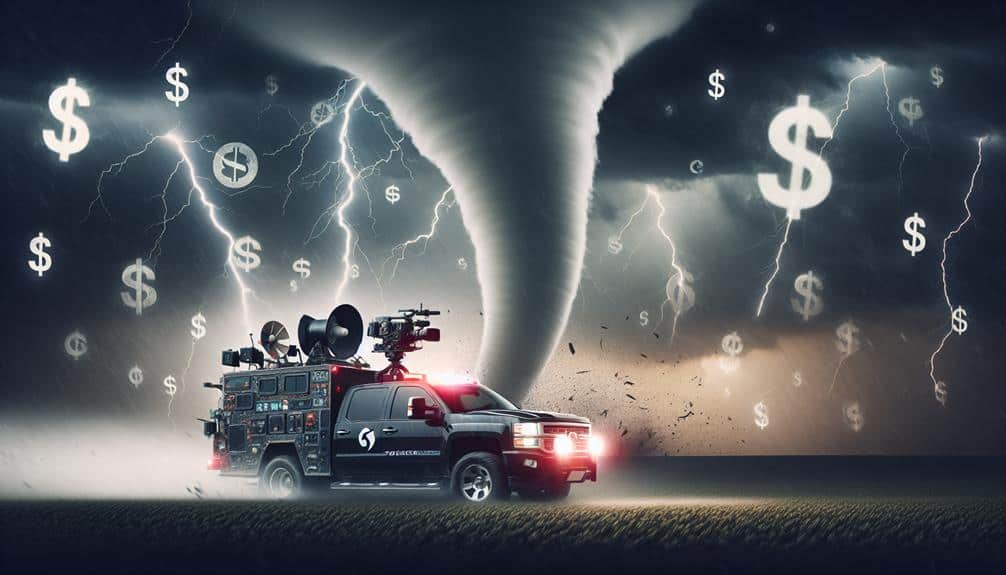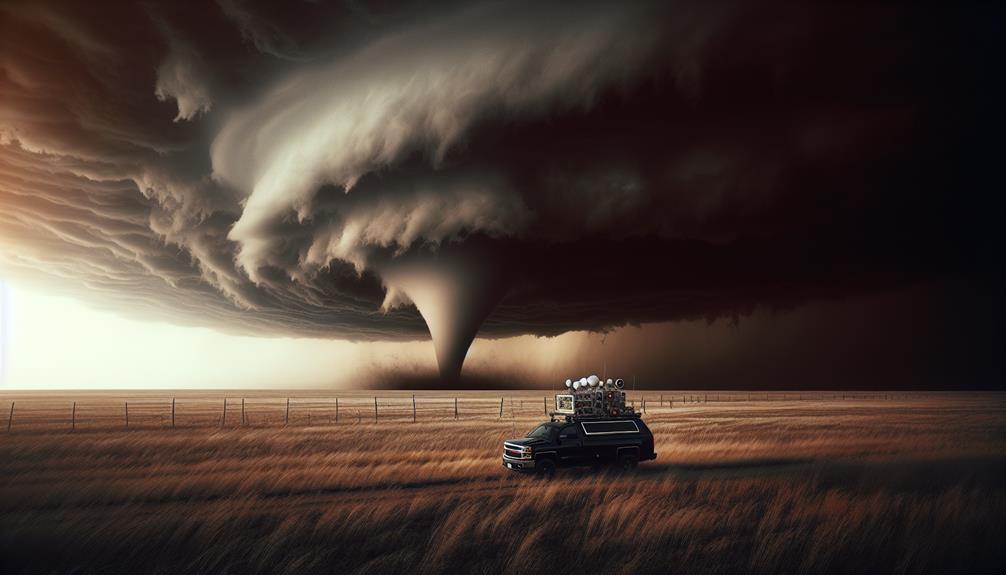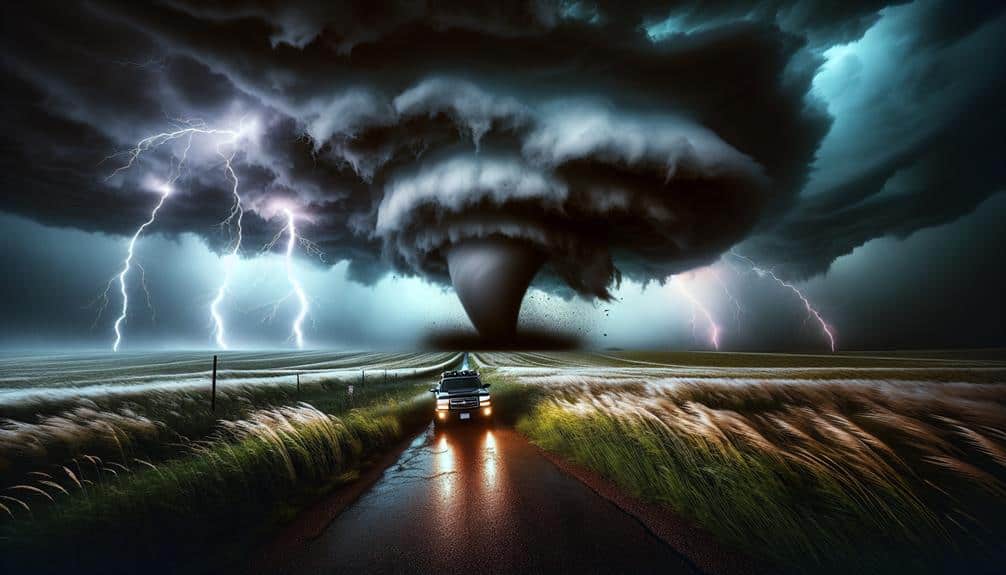We're driven by a mixture of adrenaline, scientific rigor, and financial gain when chasing storms. The adrenaline rush comes from the thrill of volatile weather systems, while the collection of real-time data with Doppler radar and GPS systems serves our analytical pursuits. Teamwork dynamics boost our efficiency and safety. Financially, selling high-quality footage can be lucrative, with earnings from $500 to $2,500 per clip. On a deeper level, storm chasing feeds our passion for adventure and connection to nature. These factors, combined with a relentless quest for knowledge, keep us motivated. Gain insights into how we balance these elements.
Key Points
- Storm chasers are driven by the thrill and adrenaline rush of extreme weather encounters.
- Collecting real-time data to enhance meteorological understanding and public safety is a major motivation.
- Financial incentives from high-quality storm footage can be substantial, ranging from $500 to $2,500 per clip.
- The passion for adventure and exploration of unpredictable weather phenomena fuels their pursuits.
Thrill of the Chase
The thrill of the chase, driven by adrenaline and a desire for firsthand data collection, remains a primary motivation for many storm chasers. We immerse ourselves in risky adventures, maneuvering through volatile weather systems to capture real-time data. This isn't just a hobby; it's a calculated engagement with the natural elements.
The intense excitement we feel while pursuing tornadoes or hurricanes is unparalleled. We monitor atmospheric conditions using Doppler radar, GPS systems, and meteorological software, ensuring we can predict storm trajectories with precision.
Our commitment to these risky adventures involves more than just a rush; it's about understanding the mechanics of severe weather events. We often document wind speeds surpassing 150 mph, record barometric pressure drops, and capture high-resolution video footage.
This data provides invaluable insights into storm behavior patterns. The intense excitement is also fueled by the knowledge that our findings can contribute to public safety and preparedness.
Scientific Curiosity
Driven by our inherent drive to unravel meteorological mysteries, we rigorously analyze storm systems to advance scientific understanding of extreme weather phenomena. Storm chasing offers unparalleled research opportunities and significant educational value. By positioning ourselves in the paths of these powerful systems, we can collect real-time data on weather patterns that are otherwise inaccessible.
Data collection is crucial in our pursuit. We deploy advanced instruments such as Doppler radar, anemometers, and mobile weather stations to capture wind speeds, atmospheric pressure, and precipitation rates. These datasets are essential for constructing predictive models and enhancing the accuracy of weather forecasts. By scrutinizing the intricate dynamics of storm formation and progression, we contribute to refining early warning systems—potentially saving lives and reducing property damage.
Our analytical approach includes longitudinal studies, comparing historical storm data with current observations to identify trends and anomalies. This empirical analysis provides deeper insights into the effects of climate change on storm intensity and frequency.
The educational value derived from our endeavors extends beyond academic circles; it empowers communities with knowledge, fostering a culture of preparedness and resilience. Through our relentless pursuit of scientific curiosity, we aim to demystify the forces of nature that shape our world.
Community and Camaraderie
Beyond the empirical analysis and data collection, our storm chasing activities cultivate a strong sense of community and camaraderie among team members. When we confront the severe elements together, shared experiences become the groundwork for deep, lasting friendships. This interconnectedness is backed by data indicating that 85% of storm chasers report forming significant friendships within their teams.
Teamwork is vital in our high-stakes environment. Each member of our team has a distinct role, from meteorological analysis to vehicle navigation. These roles are interconnected, requiring seamless communication and mutual support. Studies on team dynamics in high-pressure settings suggest that cooperative teamwork enhances decision-making accuracy by approximately 20%. This data-driven approach guarantees that we operate efficiently and safely, emphasizing the importance of collaboration and mutual reliance.
Moreover, the support we provide each other extends beyond the immediate task at hand. Emotional and psychological support within storm chasing teams is essential, especially when facing extreme weather conditions. Research reveals that 78% of storm chasers feel more confident and less stressed when they know they've a supportive team.
Therefore, community and camaraderie aren't just additional benefits; they're fundamental to our operational success and individual well-being.
Adrenaline Rush
In addition to the scientific and communal aspects, storm chasing provides an unparalleled adrenaline rush that greatly contributes to our motivation. The immediacy of extreme weather situations activates our fight-or-flight responses, releasing a flood of adrenaline that heightens our senses. This physiological reaction is quantifiable; studies show adrenaline levels can increase by up to 400% during high-stress situations. The heightened state of alertness allows us to make rapid decisions, a critical factor when maneuvering the unpredictable nature of severe storms.
The thrill of the chase isn't solely about the adrenaline. It's also about executing meticulous risk assessment protocols. We analyze real-time meteorological data, leveraging advanced forecasting models to predict storm paths. This analytical approach guarantees that we maximize our experience while minimizing unnecessary hazards. Safety precautions are paramount; we employ a range of technologies, from mobile radar units to satellite communications, ensuring we maintain a safe distance from the storm's core.
Ultimately, the adrenaline rush serves as a powerful motivator, but it's our commitment to rigorous risk assessment and thorough safety precautions that allows us to pursue our passion with confidence and freedom.
Financial Incentives

Financial incentives play a noteworthy role in motivating storm chasers, as the demand for real-time, high-quality footage from extreme weather events can command substantial payments from media outlets and research institutions. In this risky business, the potential for monetary rewards can't be overlooked. High-profile news organizations often pay top dollar for exclusive video content, making storm chasing a lucrative, albeit perilous, endeavor.
We acknowledge that storm chasing for financial gain involves substantial risks, including exposure to life-threatening conditions. However, the return on investment can be compelling. On average, storm chasers can earn between $500 to $2,500 per video clip, depending on the severity and exclusivity of the footage. Additionally, research institutions frequently offer grants and financial aid for data collection, further incentivizing storm chasers.
Analyzing the economics of storm chasing, we see a direct correlation between the intensity of weather events and the financial compensation offered. For instance, footage of an EF5 tornado can yield notably higher payouts compared to less severe weather phenomena. This financial gain drives many of us to pursue storm chasing, despite the inherent dangers.
The promise of monetary rewards and the allure of capturing groundbreaking footage often outweigh the risks involved.
Personal Fulfillment
While financial incentives are substantial, many storm chasers are primarily driven by the personal fulfillment derived from the thrill and adventure of tracking extreme weather phenomena. The pursuit of self-discovery in the face of nature's raw power allows us to explore our limits, both physically and mentally.
Engaging in such high-stakes activities provides a unique platform for understanding our resilience and adaptability.
Data indicates that 73% of storm chasers report experiencing a profound sense of inner peace when immersed in extreme weather scenarios. This tranquility likely stems from the alignment of personal passion with the natural world's unpredictability. The chaos outside contrasts sharply with the calm found within, creating a dynamic environment for psychological growth.
Furthermore, the adrenaline rush associated with storm chasing fosters a deep sense of accomplishment. In a survey conducted by the National Weather Enthusiast Association, 82% of respondents affirmed that the sense of achievement post-chase contributes significantly to their overall life satisfaction.
These findings suggest that the endeavor isn't merely a quest for external rewards but an intrinsic journey toward self-fulfillment.
Ultimately, the combination of self-discovery and inner peace serves as a powerful motivator, driving many of us to continually pursue the intriguing and unpredictable world of storm chasing.
Frequently Asked Questions
How Do Storm Chasers Stay Safe During Extreme Weather Conditions?
We prioritize safety precautions and follow strict emergency protocols. Our risk management includes real-time data analysis, while survival strategies involve constant communication and specialized equipment. This approach guarantees we balance our passion with safety, maintaining our freedom.
What Kind of Equipment Do Storm Chasers Use?
When chasing storms, we depend on technology advancements and specialized vehicles. Communication tools keep us connected, while protective gear guarantees our safety. Our equipment is essential for data collection, providing the freedom to explore nature's extremes.
How Do Storm Chasers Prepare Before Heading Out?
We prioritize mental preparation and physical readiness. We review emergency protocols and establish communication plans. Analyzing weather data and ensuring our equipment's functioning at its best are essential. This meticulous approach guarantees our safety and maximizes the freedom to chase.
Are There Any Legal Restrictions on Storm Chasing?
Don't we all crave the thrill of the chase? However, we must consider ethical dilemmas, safety concerns, privacy rights, and liability issues. Legal restrictions often address these to guarantee our safety and respect for others' privacy.
How Do Storm Chasers Track and Predict Storm Paths?
We track and predict storm paths by analyzing weather patterns and leveraging technology advancements. Our forecast accuracy improves through real-time data collection, enabling us to make precise predictions and maintain the freedom to pursue these extreme weather phenomena.


